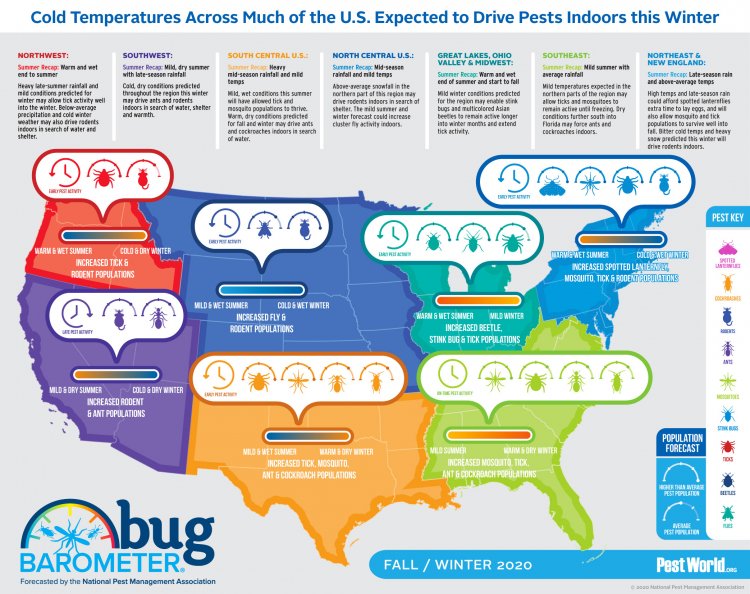Bitter Cold Temperatures Will Send Pests Scurrying to Your Home this Fall and Winter

The National Pest Management Association issues its Fall/Winter 2020 Bug Barometer® forecast
FAIRFAX, Va.: The National Pest Management Association (NPMA) has released its bi-annual Bug Barometer® forecast, a seasonal projection of the pest pressure and activity Americans can expect to see in their respective regions of the country based on weather patterns, long-term forecasts and pest biological behaviors. According to the group’s team of entomologists, the warm and wet summer experienced across most of the nation coupled with predictions of bitter cold and snow this winter will force pests indoors in droves.
“For much of the country, the end of summer brought with it tons of rain and warm temperatures, giving disease-carrying pests like mosquitoes and ticks ample time to lay eggs ahead of winter,” said Jim Fredericks, Ph.D., chief entomologist for the NPMA. “Mosquitoes and ticks, well-known vectors of deadly diseases such as West Nile virus, Eastern equine encephalitis (EEE) and Lyme disease will remain active in much of the country even as temperatures begin to drop. As we all try to soak up the last days of warmth before winter sets in, be sure to properly apply an EPA-registered insect repellent containing at least 20 percent DEET before heading outdoors and consider wearing long sleeves and pants to protect against these biting pests.”
Homeowners in the Northeast, Northwest and Southeast regions should also keep an eye out for signs of mice, rats and cockroaches, all of which pose serious health threats to humans. “Rodents and cockroaches spread countless germs and diseases and can even trigger serious allergy and asthma symptoms. Mice and rats invade an estimated 21 million U.S. homes each winter in search of shelter from bitter cold temperatures and snow, so be sure to eliminate any areas of moisture found in the home and be sure to keep your kitchen clean, storing food in airtight containers to keep pests out,” added Fredericks.
Based on this analysis, the National Pest Management Association’s Fall/Winter 2020 Bug Barometer is forecasting an increase in pest pressure across the entire U.S. this season:
Northeast & New England
High temps and late-season rain could afford spotted lanternflies extra time to lay eggs, and will also allow mosquito and tick populations to survive well into fall. Bitter cold temps and heavy snow predicted this winter will drive rodents indoors.
Great Lakes, Ohio Valley & Midwest
Mild winter conditions predicted for the region may enable stink bugs and multicolored Asian beetles to remain active longer into winter months and extend tick activity.
Southeast
Mild temperatures expected in the northern parts of the region may allow ticks and mosquitoes to remain active until freezing. Dry conditions further south into Florida may force ants and cockroaches indoors.
North Central U.S.
Above-average snowfall in the northern part of this region may drive rodents indoors in search of shelter. The mild summer and winter forecast could increase cluster fly activity indoors.
South Central U.S.
Mild, wet conditions this summer will have allowed tick and mosquito populations to thrive. Warm, dry conditions predicted for fall and winter may drive ants and cockroaches indoors in search of water.
Northwest U.S.
Heavy late-summer rainfall and mild conditions predicted for winter may allow tick activity well into the winter. Below-average precipitation and cold winter weather may also drive rodents indoors in search of water and shelter.
Southwest U.S.
Cold, dry conditions predicted throughout the region this winter may drive ants and rodents indoors in search of water, shelter and warmth.















































